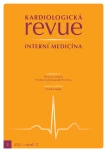Scoring systems used in atrial fibrillation
Authors:
Z. Mihalová 1,2; J. Hlásenský 1; R. Lábrová 1; J. Špinar 1,2; O. Ludka 1,2
Authors‘ workplace:
Interní kardiologická klinika LF MU a FN Brno
1; Mezinárodní centrum klinického výzkumu, FN u sv. Anny v Brně
2
Published in:
Kardiol Rev Int Med 2015, 17(2): 121-125
Category:
Cardiology Review
Overview
Atrial fibrillation (AF) with 25% lifetime risk of onset is one of the most common arrhythmias compromising quality of life. The cardiovascular epidemic of AF contributes to the onset of heart failure, in 20% of cases it causes stroke and increases total mortality. Due to a growing number of elderly individuals, AF contributes to the high socioeconomic burden, therefore there is a great need for identification of clinical factors affecting development and progression of AF and stratification of risks and complications of AF. This will lead to more effective prevention strategy in the management of AF.
Keywords:
atrial fibrillation – scoring systems – thromboembolic disease – anticoagulant therapy
Sources
1. De Vos CB, Pisters R, Nieuwlaat R et al. Progression from paroxysmal to persistent atrial fibrillation clinical correlates and prognosis. J Am Coll Cardiol 2010; 55: 725– 731. doi: 10.1016/ j.jacc.2009.11.040.
2. Barrett TW, Self WH, Wasserman BS et al. Evaluating the HATCH score for predicting progression to sustained atrial fibrillation in ED patients with new atrial fibrillation. Am J Emerg Med 2013; 31: 792– 797. doi: 10.1016/ j.ajem.2013.01.020.
3. Atrial Fibrillation Investigators. Risk factors for stroke and efficacy of antithrombotic therapy in atrial fibrillation. Analysis of pooled data from five randomized controlled trials. Arch Intern Med 1994; 154: 1449– 1457.
4. Hart RG, Pearce LA, McBride R et al. Factors associated with ischemic stroke during aspirin therapy in atrial fibrillation: analysis of 2012 participants in the SPAF I– III clinical trials. The Stroke Prevention in Atrial Fibrillation (SPAF) Investigators. Stroke 1999; 30: 1223– 1229.
5. Sixth ACCP Consensus Conference on Antithrombotic Therapy. Quick Reference Guide. Chest 2001; 119 (Suppl 1): 1S– 2S.
6. Gage BF, Waterman AD, Shannon W et al. Validation of clinical classification schemes for predicting stroke: results from the National Registry of Atrial Fibrillation. JAMA 2001; 285: 2864– 2870.
7. Rietbrock S, Heeley E, Plumb J et al. Chronic atrial fibrillation: incidence, prevalence, and prediction of stroke using the congestive heart failure, hypertension, age greater than 75, diabetes mellitus, and prior stroke or transient ischemic attack (chads2) risk stratification scheme. Am Heart J 2008; 156: 57– 64. doi: 10.1016/ j.ahj.2008.03.010.
8. Wang TJ, Massaro JM, Levy D et al. A risk score for predicting stroke or death in individuals with new‑onset atrial fibrillation in the communitythe Framingham heart study FREE. JAMA 2003; 290: 1049– 1056.
9. Lip GY, Lane D, Van Walraven C et al. Additive role of plasma von Willebrand factor levels to clinical factors for risk stratification of patients with atrial fibrillation. Stroke 2006; 37: 2294– 2300.
10. Lip GY, Nieuwlaat R, Pisters R et al. Refining clinical risk stratification for predicting stroke and thromboembolism in atrial fibrillation using a novel risk factor‑based approach: the euro heart survey on atrial fibrillation. Chest 2010; 137: 263– 272. doi: 10.1378/ chest.09‑ 1584.
11. Beyth RJ, Quinn LM, Landefeld CS. Prospective evaluation of an index for predicting the risk of major bleeding in outpatients treated with warfarin. Am J Med 1998;105: 91– 99.
12. Kuijer P, Hutten B, Prins MH et al. Prediction of the risk of bleeding during anticoagulant treatment for venous thromboembolism. Arch Intern Med 1999; 159: 457– 460.
13. Gage BF, Yan Y, Milligan PE et al. Clinical classification schemes for predicting hemorrhage: results from the National Registry of Atrial Fibrillation (NRAF). Am Heart J 2006; 151: 713– 719.
14. Shireman TI, Mahnken JD, Howard PA et al. Development of a contemporary bleeding risk model for elderly warfarin recipients. Chest 2006; 130: 1390– 1396.
15. Ruíz‑ Giménez N, Suárez C, González R et al. RIETE Investigators. Predictive variables for major bleeding events in patients presenting with documented acute venous thromboembolism. Findings from the RIETE Registry. Thromb Haemost 2008; 100: 26– 31. doi: 10.1160/ TH08‑ 03‑ 0193.
16. Pisters R, Lane DA, Nieuwlaat R et al. A novel user‑ friendly score (HAS‑ BLED) to assess 1‑year risk of major bleeding in patients with atrial fibrillation: the Euro Heart Survey. Chest 2010; 138: 1093– 1100. doi: 10.1378/ chest.10‑ 0134.
17. Fang MC, Go AS, Chang Y et al. A new risk scheme to predict warfarin‑associated hemorrhage: The ATRIA (Anticoagulation and Risk Factors in Atrial Fibrillation) Study. J Am Coll Cardiol 2011; 58: 395– 401. doi: 10.1016/ j.jacc.2011.03.031.
18. Apostolakis S, Sullivan RM, Olshansky B et al. Factors affecting quality of anticoagulation control among patients with atrial fibrillation on warfarin: the SAMe‑ TT₂R₂ score. Chest 2013; 144: 1555– 1563. doi: 10.1378/ chest.13‑ 0054.
Labels
Paediatric cardiology Internal medicine Cardiac surgery CardiologyArticle was published in
Cardiology Review

2015 Issue 2
Most read in this issue
- Clinical classification and scoring systems in heart failure
- Scoring systems for venous thromboembolic disease
- Differential diagnosis of hyponatraemia
- Acute conditions in medicine of thyroid gland
